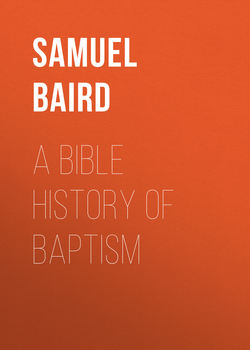Читать книгу A Bible History of Baptism - Baird Samuel John - Страница 23
Book I.
OLD TESTAMENT HISTORY
Part III.
ADMINISTERED BAPTISMS=SPRINKLINGS
Section XX. —These all were one Baptism
ОглавлениеThe baptism of the Levites was official and peculiar. Its analogies to the other examples will readily occur to the reader, as we proceed. As to them, there is a common identity in all essential points, in form, meaning, and office. The design of the first administration at Sinai, and of all the attendant circumstances, was to impress Israel with a profound and abiding sense of the evil of sin, and of their own utter vileness and ruin as sinners in the presence of a God of infinite power, majesty, and holiness; and to illustrate to them the manner in which grace and salvation are given. In accepting that baptism, Israel professed to submit themselves to his sovereignty and accept him in the offices of his grace, as symbolized in the baptismal rites. On God’s behalf, the transaction was an acceptance and acknowledgment of them as his covenant people. The laws of defilement and the rites of purifying were continual reminders and re-enactings of the Sinai transaction, and for the same essential purpose, – the restoring to the fellowship of the covenant of those who came under its forfeiture. In each several case, sacrificial elements – blood or ashes – were applied by sprinkling. In each, those elements were mingled with running water, and the instrument for sprinkling was a bush of hyssop, and in each, scarlet and cedar were used.
The meaning of the scarlet, cedar, and hyssop is unexplained in the Scriptures. Expositors have wandered in conjectures, leading to no satisfactory conclusions. One result of their use is manifest. To us, devoid of meaning, they more distinctly mark the essential identity of the rites, in which they occupy the same place, and perform the same office. This may have been one design of their use.
The essential identity of these rites is altogether consistent with the minute variations in their forms. These had respect to the diversity of circumstances under which they were administered. The inferior dignity of a single person, a leper, as compared with the whole people, explains the acceptance of lambs or birds for his offerings, while bulls and goats were sacrificed for the nation. In the case of ordinary uncleannesses, the circumstances rendered special provision necessary. Sacrifice was lawful only at the sanctuary, which was the figure of the one holy place and altar where Christ ministers in heaven. But death and other causes of uncleanness were occurring everywhere. The ashes of the red heifer were, therefore, provided. They presented sacrificial elements in a form incorruptible and convenient for transportation. They were a most fitting representation of the “incorruptible blood of Christ.” And, as the proper place of the priests was at the sanctuary, and their presence could not be expected on every occasion of uncleanness elsewhere, it was appointed that any clean person might perform the sprinkling. This was, in fact, a mere ministerial sequel to the sacrificial rites, performed by the priest, at the burning of the red heifer. The probability of the circumstances, and intimations from the rabbins, lead to the conclusion that, as the priests multiplied and were released from the necessity of constant attendance at the sanctuary, they were commonly called to sprinkle the water of purifying. In fact, the Talmud indicates that in the later times the administration, when practicable, took place at Jerusalem, by the hands of the priests, with water from the pool of Siloam, which, flowing from beneath the temple, was recognized as a type of the Holy Spirit.11
The minute variations traceable in these rites only make it the more clear that essentially, in form, meaning, and office, they were one baptism.
11
Compare Ezek. xlvii, 2; John ix, 7. “Go wash in the pool of Siloam, which is by interpretation, Sent.”
